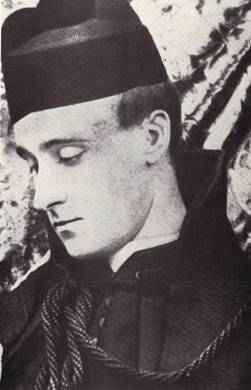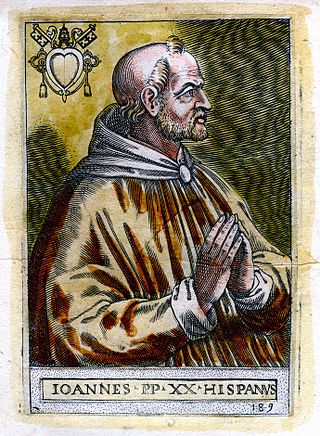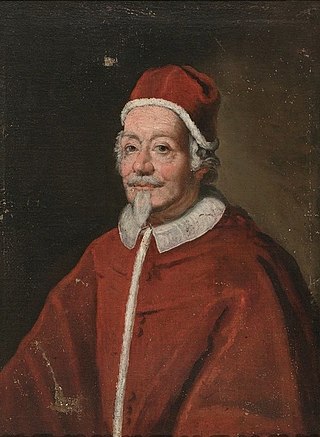
Pope Gregory X, born Teobaldo Visconti, was head of the Catholic Church and ruler of the Papal States from 1 September 1271 to his death and was a member of the Secular Franciscan Order. He was elected at the conclusion of a papal election that ran from 1268 to 1271, the longest papal election in the history of the Catholic Church.

Pope Callixtus III, born Alfonso de Borgia, was head of the Catholic Church and ruler of the Papal States from 8 April 1455 to his death, in August 1458.

Pope John XXII, born Jacques Duèze, was head of the Catholic Church from 7 August 1316 to his death, in December 1334. He was the second and longest-reigning Avignon Pope, elected by the Conclave of Cardinals, which was assembled in Lyon. Like his predecessor, Clement V, Pope John centralized power and income in the Papacy and lived a princely life in Avignon.

Frederick William Rolfe, better known as Baron Corvo, and also calling himself Frederick William Serafino Austin Lewis Mary Rolfe, was an English writer, artist, photographer and eccentric.
Papabile is an unofficial Italian term first coined by Vaticanologists and now used internationally in many languages to describe a Catholic man, in practice always a cardinal, who is thought a likely or possible candidate to be elected pope.

A papal conclave is a gathering of the College of Cardinals convened to elect a bishop of Rome, also known as the pope. Catholics consider the pope to be the apostolic successor of Saint Peter and the earthly head of the Catholic Church.

Pedro Martínez de Luna y Pérez de Gotor, known as el Papa Luna(lit. 'the Moon Pope') or Pope Luna, was an Aragonese nobleman who was christened antipope Benedict XIII during the Western Schism.

The papal conclave held from 2 to 28 September 1823 ended with the election of Annibale della Genga to succeed the death recently deceased Pius VII as pope. Della Genga took the name Leo XII.
Acclamation was formerly one of the methods of papal election.
Jus exclusivae was the right claimed by several Catholic monarchs of Europe to veto a candidate for the papacy. Although never formally recognized by the Catholic Church, the monarchs of France, Spain and Austria claimed this right at various times, making known to a papal conclave, through a crown-cardinal, that the monarch deemed a particular candidate for the papacy objectionable.

The September 1276 papal election is the only papal election to be the third election held in the same year; after Pope Gregory X died, two successors died that year, requiring yet another election. The election was also the first non-conclave, since the establishment of the papal conclave after the papal election, 1268–1271.

The 1294 papal conclave was convoked in Naples after the resignation of Pope Celestine V on 13 December 1294. Celestine V had only months earlier restored the election procedures set forth in the papal bull Ubi periculum of Pope Gregory X, which had been suspended by Pope Adrian V in July 1276. Every papal election since then has been a papal conclave. It was the first papal conclave held during the lifetime of the preceding pontiff, an event not repeated until the 2013 papal conclave following the resignation of Pope Benedict XVI.

The 1676 papal conclave was convened after the death of Pope Clement X and lasted from 2 August until 21 September 1676. It led to the election of Cardinal Benedetto Odescalchi as Pope Innocent XI.

The 1689 papal conclave was convened after the death of Pope Innocent XI. It led to the election of Cardinal Pietro Vito Ottoboni as Pope Alexander VIII. The conclave saw previous factions join together because they lacked numerical strength, and saw the rise of the zelanti as a political force in the election of the next pope. Ottoboni was eventually unanimously elected with the consent of the secular monarchs, becoming the first Venetian in over 200 years to be elected pope.

Francesco Maidalchini was an Italian Cardinal of the Roman Catholic Church.

The 1691 papal conclave was convened on the death of Pope Alexander VIII and ended with the election of Cardinal Antonio Pignatelli as Pope Innocent XII. It lasted for five months, from 12 February to 12 July 1691. The conclave became deadlocked after Catholic monarchs opposed the election of Gregorio Barbarigo, who some members of the College of Cardinals also viewed as too strict. The conclave only ended in July when cardinals started to become ill from the heat, and after French cardinals agreed to vote for Pignatelli despite him coming from Spanish-controlled Naples.

Mark Sittich von Hohenems Altemps (1533–1595) was a German Roman Catholic bishop and cardinal. The addition of Altemps to the family name reflects Alt-Ems itself deriving from "Alta Embs", like the modern name Hohenems.

Giovanni Vincenzo Gonzaga (1540–1591) was an Italian Roman Catholic cardinal.

Francesco Sforza (1562–1624) was an Italian cardinal and bishop. He was very influential in a number of conclaves.
Hubert's Arthur is an alternative history novel by the eccentric English writer Frederick Rolfe posthumously published by A. J. A. Symons in 1935. It started as a collaboration between Rolfe and Harry Pirie-Gordon, but in the end the latter only supplied the copious heraldic details pertaining to the characters.
















